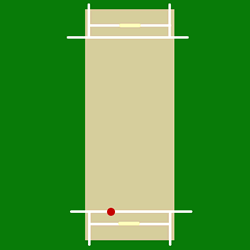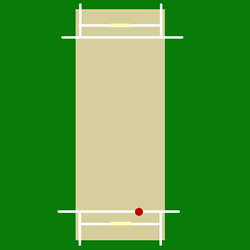
A Cartesian coordinate system is a coordinate system that specifies each point uniquely in a plane by a set of numerical coordinates, which are the signed distances to the point from two fixed perpendicular oriented lines, measured in the same unit of length. Each reference line is called a coordinate axis or just axis of the system, and the point where they meet is its origin, at ordered pair (0, 0). The coordinates can also be defined as the positions of the perpendicular projections of the point onto the two axes, expressed as signed distances from the origin.

Off spin is a type of finger spin bowling in the sport of cricket. A bowler who uses this technique is called an off spinner. Off spinners are right-handed spin bowlers who use their fingers to spin the ball from a right-handed batsman's off side to the leg side. This contrasts with leg spin, in which the ball spins from leg to off and which is bowled with a very different action.

Precession is a change in the orientation of the rotational axis of a rotating body. In an appropriate reference frame it can be defined as a change in the first Euler angle, whereas the third Euler angle defines the rotation itself. In other words, if the axis of rotation of a body is itself rotating about a second axis, that body is said to be precessing about the second axis. A motion in which the second Euler angle changes is called nutation. In physics, there are two types of precession: torque-free and torque-induced.

A rotation is a circular movement of an object around a center of rotation. A three-dimensional object can always be rotated around an infinite number of imaginary lines called rotation axes. If the axis passes through the body's center of mass, the body is said to rotate upon itself, or spin. A rotation about an external point, e.g. the Earth about the Sun, is called a revolution or orbital revolution, typically when it is produced by gravity. The axis is called a pole.
In cricket, a googly is a type of deceptive delivery bowled by a right-arm leg spin bowler. In Australia, it is occasionally referred to as a wrong'un, Bosie or Bosey, the last two eponyms in honour of its inventor Bernard Bosanquet. A leg spin bowler bowls in a leg spin way but it goes in the off spin direction.

Standard anatomical terms of location deal unambiguously with the anatomy of animals, including humans.
In mathematics, the special orthogonal group in three dimensions, otherwise known as the rotation group SO(3), is a naturally occurring example of a manifold. The various charts on SO(3) set up rival coordinate systems: in this case there cannot be said to be a preferred set of parameters describing a rotation. There are three degrees of freedom, so that the dimension of SO(3) is three. In numerous applications one or other coordinate system is used, and the question arises how to convert from a given system to another.

Pen spinning is a form of object manipulation that involves the deft manipulation of a writing instrument with one's hands. Although it is often considered a form of self-entertainment, multinational competitions and meetings are sometimes held. It is sometimes classified as a form of contact juggling; however, some tricks do leave contact with the body. Pen spinning is called pen mawashi or, more rarely and disparagingly, rōnin mawashi in Japan, where the pastime has been popular since at least the 1970s and where the Pen Spinning Association Japan is now dedicated to promoting the aspiring art form. Pen spinning has quickly gained international popularity through online video sharing and forums. According to Masaki Tsukada, chairman of the Japanese pen spinners, pen spinning now has dedicated movements in South Korea and the United States.

Juggling clubs are a prop used by jugglers. Juggling clubs are often simply called clubs by jugglers and sometimes are referred to as pins or batons by non-jugglers. Clubs are one of the three most popular props used by jugglers; the others being balls and rings.

Wrist spin is a type of bowling in the sport of cricket. It refers to the cricket technique and specific hand movements associated with imparting a particular direction of spin to the cricket ball. The other spinning technique, usually used to spin the ball in the opposite direction, is finger spin. Wrist spin is bowled by releasing the ball from the back of the hand, so that it passes over the little finger. Done by a right-handed bowler, this imparts an anticlockwise rotation to the ball, as seen from the bowler's perspective; a left-handed wrist spinner rotates the ball clockwise.

The tailwhip is a bike trick typically performed on a BMX, in which the frame of the bike performs a complete rotation around the front end, which remains stationary throughout the move. The same trick may also be performed on a kick scooter.
In geometry, Hermann–Mauguin notation is used to represent the symmetry elements in point groups, plane groups and space groups. It is named after the German crystallographer Carl Hermann and the French mineralogist Charles-Victor Mauguin. This notation is sometimes called international notation, because it was adopted as standard by the International Tables For Crystallography since their first edition in 1935.

Motion, the process of movement, is described using specific anatomical terms. Motion includes movement of organs, joints, limbs, and specific sections of the body. The terminology used describes this motion according to its direction relative to the anatomical position of the joints. Anatomists use a unified set of terms to describe most of the movements, although other, more specialized terms are necessary for describing the uniqueness of the movements such as those of the hands, feet, and eyes.
Some poi tricks include: reels, weaves, fountains, crossovers and windmills.
Object manipulation is a form of dexterity play or performance in which one or more people physically interact with one or more objects. Many object manipulation skills are recognised circus skills. Other object manipulation skills are linked to sport, magic, and everyday objects or practices. Many object manipulation skills use special props made for that purpose: examples include the varied circus props such as balls, clubs, hoops, rings, poi, staff, and devil sticks; magic props such as cards and coins; sports equipment such as nunchaku and footballs. Any other object can also be used for manipulation skills. Object manipulation with ordinary items may be considered to be object manipulation when the object is used out of its socially acknowledged context and used differently from its original purpose.
3D Aerobatics or 3D flying is a form of flying using flying aircraft to perform specific aerial maneuvers. They are usually performed when the aircraft had been intentionally placed in a stalled position.

A falling leaf is an aerobatic maneuver in which an aircraft performs a wings-level stall which begins to induce a spin. This spin is countered with the rudder, which begins a spin in the opposite direction that must be countered with rudder, and the process is repeated as many times as the pilot determines. During the maneuver, the plane resembles a leaf falling from the sky; first slipping to one side, stopping, and then slipping to the other direction; continuing a side-to-side motion as it drifts toward the ground.




















